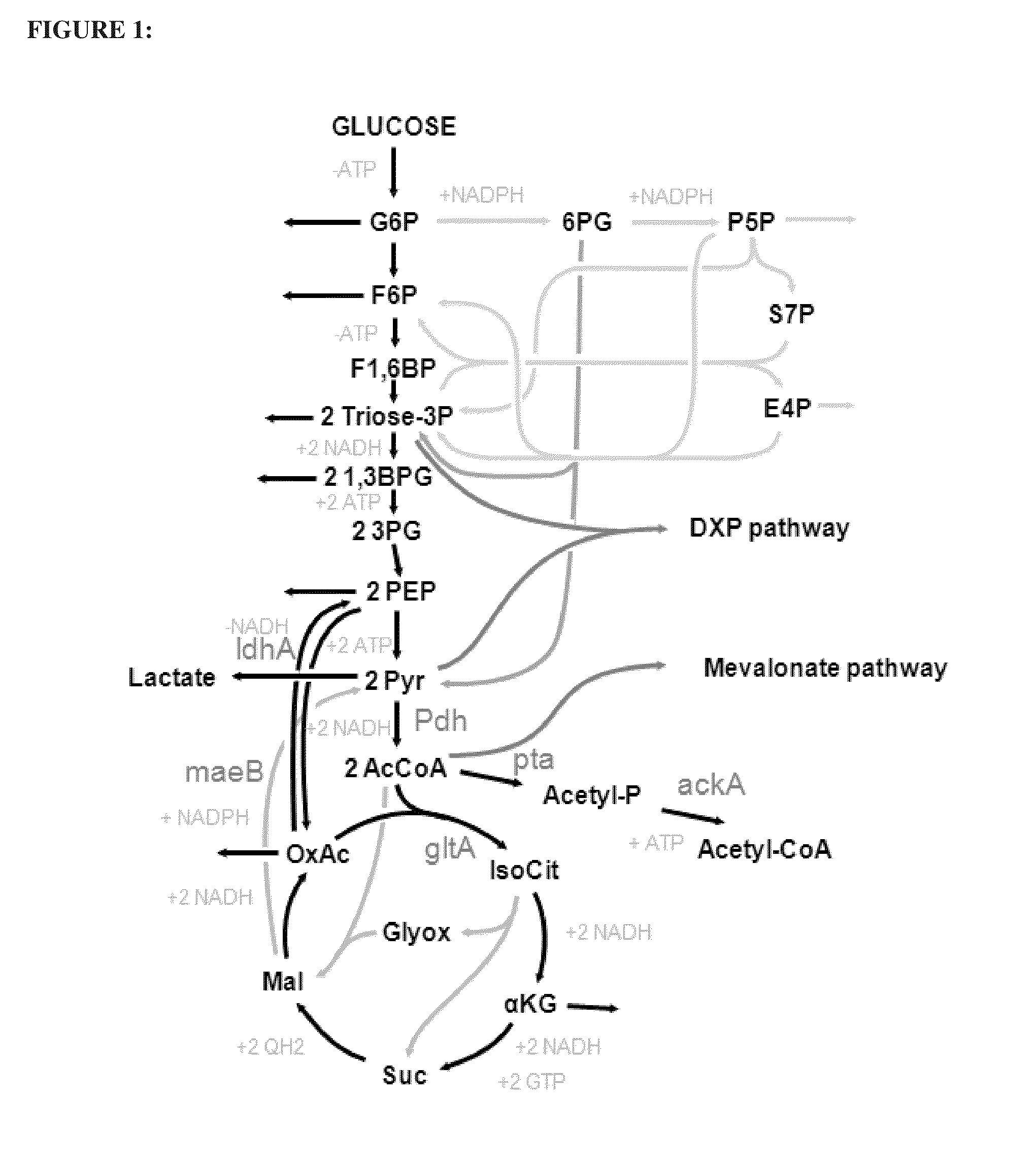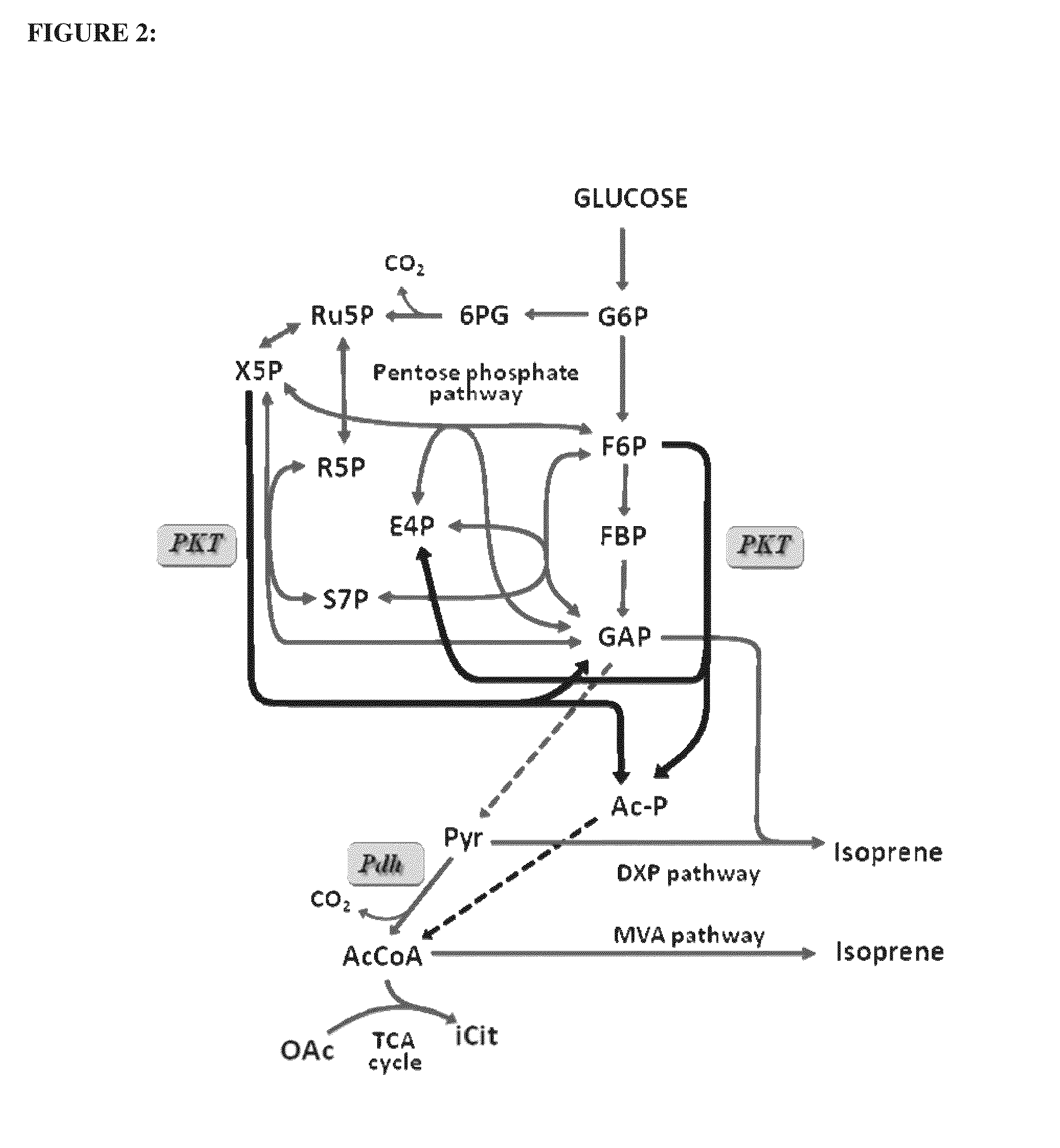Utilization of phosphoketolase in the production of mevalonate, isoprenoid precursors, and isoprene
a technology of phosphoketolase and mevalonate, which is applied in the field of cultured recombinant cells, can solve the problems of unsatisfactory means, inability to synthesis organically, and high cost of purification of this material
- Summary
- Abstract
- Description
- Claims
- Application Information
AI Technical Summary
Benefits of technology
Problems solved by technology
Method used
Image
Examples
example 1
Cloning of the Gene Encoding Phosphoketolase Enzyme from Bifidobacterium infantis
[0393]Chromosomal DNA of Bifidobacterium infantis was obtained from ATCC (ATCC#15697D-5, ATCC, Manassas, Va.). The gene encoding phosphoketolase (PKL) enzyme was amplified using primers CMP283: 5′-ctgtatTCATGAcgagtcctgttattggcacc-3′ (SEQ ID NO:30) and CMP284: 5′-ctctatGAATTCTCACTCGTTGTCGCCAGCG-3′ (SEQ ID NO:31), 100 ng DNA as template and the polymerase Herculase II Fusion according to the manufacturer (Agilent, Santa Clara, Calif.). After purification, the 2798 by fragment was digested with BspHI and EcoRI, and ligated with NcoI / EcoRI-digested pTrcHis2B (Invitrogen, Carlsbad, Calif.) to form plasmid pCMP1090 (SEQ ID NO: 15-FIG. 6).
example 2
Cloning of Phosphoketolase Enzyme from Lactobacillus reuteri Strain F275
[0394]Chromosomal DNA of Lactobacillus reuteri strain F275 was obtained from ATCC (ATCC#23272D-5, ATCC, Manassas, Va.). The gene encoding phosphoketolase (PKL) enzyme was amplified using primers CMP34: 5′-taaggaggaataaacATGGCAGTAGATTACGATTCCAAG-3′ (SEQ ID NO:32) and CMP335: 5′-ttctagaaagcttcgttacttaagacccttccaagtccag-3′ (SEQ ID NO:33), 100 ng DNA as template and the polymerase Herculase II Fusion according to the manufacturer (Agilent, Santa Clara, Calif.). After purification, the 2442 by fragment was assembled into NcoI / EcoRI-digested pTrcHis2B (Invitrogen, Carlsbad, Calif.) using the GENEART seamless cloning kit (Invitrogen, Carlsbad, Calif.) to form plasmid pCMP1029 (SEQ ID NO:16-FIG. 7).
example 3
Construction of Strains CMP451, CMP674, CMP1015 and CMP1047 (BL21 GI1.2 gltA ldhA)
[0395]The promoter in front of the citrate synthase gene (gltA) in E. coli strain BL21 (Novagen) was previously replaced by a constitutive low expression promoter, namely GI1.2 (U.S. Pat. No. 7,371,558). Two wild-type promoters have been described for gltA (Wilde, R, and J. Guest. 1986. J. Gen. Microbiol. 132:3239-3251). The synthetic promoter was inserted just after the −35 region of the distal promoter. A PCR product was obtained using primers UpgltACm-F (5′-TATTTAATTTTTAATCATCTAATTTGACAATCATTCAACAAAGTTGTTACAATTAACCCT CACTAAAGGGCGG-3′ (SEQ ID NO:34)) and DngltAl.xgiCm-R (5′-TCAACAGCTGTATCCCCGTTGAGGGTGAGTTTTGCTTTTGTATCAGCCATATATTCCACC AGCTATTTGTTAGTGAATAAAAGTGGTTGAATTATTTGCTCAGGATGTGGCATHGTCAA GGGCTAATACGACTCACTATAGGGCTCG-3′ (SEQ ID NO:35)), and plasmid FRT-gb2-Cm-FRT from Gene Bridges (Heidelberg, Germany) as a template. The PCR product was purified and used in a lambda red-mediated recombination as ...
PUM
 Login to View More
Login to View More Abstract
Description
Claims
Application Information
 Login to View More
Login to View More - R&D
- Intellectual Property
- Life Sciences
- Materials
- Tech Scout
- Unparalleled Data Quality
- Higher Quality Content
- 60% Fewer Hallucinations
Browse by: Latest US Patents, China's latest patents, Technical Efficacy Thesaurus, Application Domain, Technology Topic, Popular Technical Reports.
© 2025 PatSnap. All rights reserved.Legal|Privacy policy|Modern Slavery Act Transparency Statement|Sitemap|About US| Contact US: help@patsnap.com



